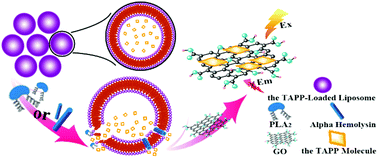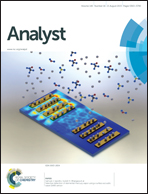Porphyrin-loaded liposomes and graphene oxide used for the membrane pore-forming protein assay and inhibitor screening†
Abstract
The interaction of planar aromatic molecules with the graphene oxide (GO) sheets is often marked by the fluorescence quenching of the former. Here, the α,β,γ,δ-tetrakis[4-(trimethylammoniumyl)phenyl]porphyrin (TAPP) molecules and the GO, corresponding to the energy donor and the acceptor respectively, are initially separated by encapsulating the TAPP molecules within the liposomes, to obstruct the formation of the self-assembled energy transfer-based quenching system. Upon disruption of the liposome membranes by the PLA2 or the α-toxin, the encapsulated TAPP molecules are released and subsequently result in significant fluorescence changes. Thus, a platform based on the fluorescence signal for monitoring the activity of the membrane pore-forming protein with advantages of high sensitivity and commonality was established. Using this strategy, we can detect the PLA2 and the α-toxin concentrations as low as 200 pM and 9.0 nM, respectively. Furthermore, by taking chlorpromazine and baicalin as the examples, we use the assay to evaluate the prohibition effects on the PLA2 and the α-toxin, and the IC50 values of chlorpromazine toward the PLA2 (9.6 nM) and that of baicalin toward the α-toxin (289.2 nM) were found to be 12.0 ± 0.62 μM and 26.9 ± 2.6 μM, respectively.


 Please wait while we load your content...
Please wait while we load your content...